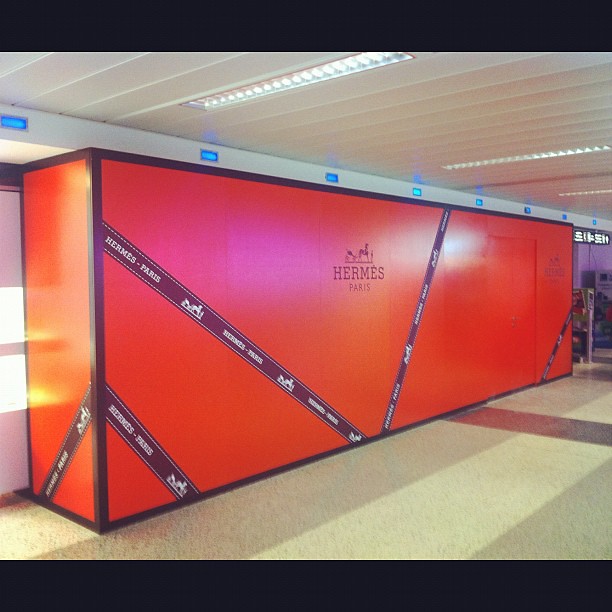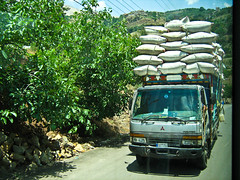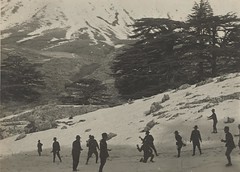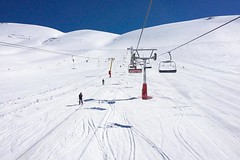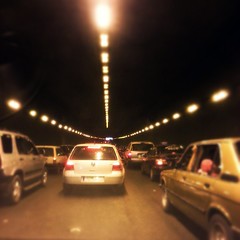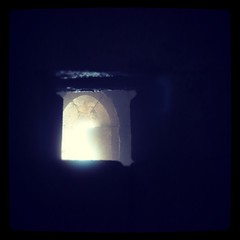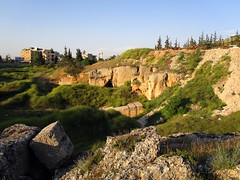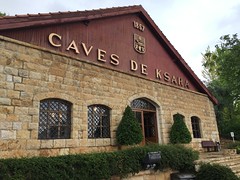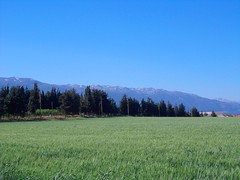 Lebanon
Lebanon
Lebanon (English: /ˈlɛbənɒn-nən/ ; Arabic: لُبْنَان, ; French: Liban), officially the Republic of Lebanon or the Lebanese Republic, is a country in Western Asia. It is located between Syria to the north and east and Israel to the south, while Cyprus lies to its west across the Mediterranean Sea; its location at the crossroads of the Mediterranean Basin and the Arabian hinterland has contributed to its rich history and shaped a cultural identity of religious diversity. It is part of the Levant region of the Middle East. Lebanon is home to more than five million people and covers an area of , making it the second-smallest country in continental Asia. The official language of the state is Arabic, while French is also formally recognized; Lebanese Arabic is used alongside Modern Standard Arabic throughout the country.
The earliest evidence of civilization in Lebanon dates back to 5,000 BCE. From , it was home to the flourishing Phoenician civilization before being annexed by various Near Eastern empires. In 64 BC, the Roman Empire conquered the region, and the region became a major center for Christianity under the Byzantine Empire. In the 7th century, the Muslim conquest of the Levant established caliphal rule. The 11th century saw the start of the Crusades and the establishment of Crusader States in the region only for it to be later reclaimed by the Ayyubids and Mamluks before being ceded to the Ottoman Empire in the 16th century. Under Sultan Abdulmejid I, the first Lebanese protostate took form in the 19th century as the Mount Lebanon Mutasarrifate, created as a home for the Maronite Christians under the Tanzimat reforms.
Following the Ottoman Empire's collapse after World War I, the five Ottoman provinces constituting modern-day Lebanon came under the French Mandate for Syria and the Lebanon, under which its French-ruled predecessor state of Greater Lebanon was established. Following the invasion and occupation of the French Third Republic by Nazi Germany during World War II, French rule over the region weakened. Upon gaining its independence from Free France in 1943, Lebanon established a unique confessionalist form of government, with the state's major religious sects being apportioned specific political powers. Lebanon initially was relatively stable. This stability was short-lived and was ultimately shattered by the outbreak of large-scale fighting in the Lebanese Civil War (1975–1990) between various political and sectarian factions. During this period, Lebanon was also subjected to overlapping foreign military occupations by Syria from 1976 to 2005 and by Israel from 1985 to 2000. Since the end of the war, there have been extensive efforts to revive the economy and rebuild national infrastructure.
Lebanon is a developing country, ranking 112th on the Human Development Index. It has been classified as an upper middle income state. However, the Lebanese liquidity crisis, corruption as well as recent events have precipitated the collapse of currency, political instability, widespread shortages, high unemployment and poverty. The World Bank defined the economic crisis in Lebanon as one of the worst in the world since the 19th century. Despite the country's small size, Lebanese culture is renowned both in the Middle East and globally, primarily powered by its extensive diaspora. Lebanon is a founding member of the United Nations and is a member of the Arab League, the Non-Aligned Movement, the Organization of Islamic Cooperation, and the Organisation internationale de la Francophonie.
Etymology
The name of Mount Lebanon originates from the Phoenician root meaning "white", apparently from its snow-capped peaks.
Occurrences of the name have been found in different Middle Bronze Age texts from the library of Ebla, and three of the twelve tablets of the Epic of Gilgamesh. The name is recorded in Ancient Egyptian as Rmnn (?????), where R stood for Canaanite L. The name occurs nearly 70 times in the Hebrew Bible, as .
Lebanon as the name of an administrative unit (as opposed to the mountain range) that was introduced with the Ottoman reforms of 1861, as the Mount Lebanon Mutasarrifate (Arabic: متصرفية جبل لبنان; Turkish: Cebel-i Lübnan Mutasarrıflığı), continued in the name of the State of Greater Lebanon (Arabic: دولة لبنان الكبير ; French: État du Grand Liban) in 1920, and eventually in the name of the sovereign Republic of Lebanon (Arabic: الجمهورية اللبنانية) upon its independence in 1943.
History
The borders of contemporary Lebanon are a product of the Treaty of Sèvres of 1920. Its territory was in the core of the Bronze Age Canaanite (Phoenician) city-states. As part of the Levant, it was part of numerous succeeding empires throughout ancient history, including the Egyptian, Assyrian, Babylonian, Achaemenid Persian, Hellenistic, Roman and Sasanid Persian empires.
After the 7th-century Muslim conquest of the Levant, it was part of the Rashidun, Umayyad, Abbasid Seljuk and Fatimid empires. The crusader state of the County of Tripoli, founded by Raymond IV of Toulouse in 1102, encompassed most of present-day Lebanon, falling to the Mamluk Sultanate in 1289 and finally to the Ottoman Empire in 1516. With the dissolution of the Ottoman Empire, Greater Lebanon fell under French mandate in 1920, and gained independence under president Bechara El Khoury in 1943. Lebanon's history since independence has been marked by alternating periods of relative political stability and prosperity based on Beirut's position as a regional center for finance and trade, interspersed with political turmoil and armed conflict (1948 Arab–Israeli War, Lebanese Civil War 1975–1990, 2005 Cedar Revolution, 2006 Lebanon War, 2007 Lebanon conflict, 2006–08 Lebanese protests, 2008 conflict in Lebanon, 2011 Syrian Civil War spillover, and 2019–20 Lebanese protests).
Ancient Lebanon
Evidence dating back to an early settlement in Lebanon was found in Byblos, considered among the oldest continuously inhabited cities in the world. The evidence dates back to earlier than 5000 BC. Archaeologists discovered remnants of prehistoric huts with crushed limestone floors, primitive weapons, and burial jars left by the Neolithic and Chalcolithic fishing communities who lived on the shore of the Mediterranean Sea over 7,000 years ago.
Lebanon was part of northern Canaan, and consequently became the homeland of Canaanite descendants, the Phoenicians, a seafaring people who spread across the Mediterranean in the first millennium BC. The most prominent Phoenician cities were Byblos, Sidon and Tyre, while their most famous colonies were Carthage in present-day Tunisia and Cádiz in present-day Spain. The Phoenicians are credited with the invention of the oldest verified alphabet, which subsequently inspired the Greek alphabet and the Latin one thereafter. The cities of Phoenicia were incorporated into the Persian Achaemenid Empire by Cyrus the Great in 539 BCE. The Phoenician city-states were later incorporated into the empire of Alexander the Great following the siege of Tyre in 332 BC.
In 64 BC, the Roman general Pompey the Great had the region of Syria annexed into the Roman Republic. The region was then split into two Imperial Provinces under the Roman Empire, Coele Syria and Phoenice, the latter which the land of present-day Lebanon was a part of.
Medieval Lebanon
The region that is now Lebanon, as with the rest of Syria and much of Anatolia, became a major center of Christianity in the Roman Empire during the early spread of the faith. During the late 4th and early 5th century, a hermit named Maron established a monastic tradition focused on the importance of monotheism and asceticism, near the Mediterranean mountain range known as Mount Lebanon. The monks who followed Maron spread his teachings among Lebanese in the region. These Christians came to be known as Maronites and moved into the mountains to avoid religious persecution by Roman authorities. During the frequent Roman-Persian Wars that lasted for many centuries, the Sassanid Persians occupied what is now Lebanon from 619 till 629.
During the 7th century, the Muslim Arabs conquered Syria establishing a new regime to replace the Byzantines. Though Islam and the Arabic language were officially dominant under this new regime, the general populace nonetheless only gradually converted from Christianity and the Syriac language. The Maronite community, in particular, managed to maintain a large degree of autonomy despite the succession of rulers over Lebanon and Syria.
The relative (but not complete) isolation of the Lebanese mountains meant the mountains served as a refuge in the times of religious and political crises in the Levant. As such, the mountains displayed religious diversity and the existence of several well-established sects and religions, notably, Maronites, Druze, Shiite Muslims, Ismailis, Alawites and Jacobites.
During the 11th century, the Druze religion emerged from a branch of Shia Islam. The new religion gained followers in the southern portion of Mount Lebanon. The southern portion of Mount Lebanon was ruled by Druze feudal families till the early 14th century. The Maronite population increased gradually in Northern Mount Lebanon and the Druze have remained in Southern Mount Lebanon until the modern era. Keserwan, Jabal Amel and the Beqaa Valley was ruled by Shia feudal families under the Mamluks and the Ottoman Empire. Major cities on the coast, Sidon, Tyre, Acre, Tripoli, Beirut, and others, were directly administered by the Muslim Caliphs and the people became more fully absorbed by the Arab culture.
Following the fall of Roman Anatolia to the Muslim Turks, the Byzantines put out a call to the Pope in Rome for assistance in the 11th century. The result was a series of wars known as the Crusades launched by the Franks from Western Europe to reclaim the former Byzantine Christian territories in the Eastern Mediterranean, especially Syria and Palestine (the Levant). The First Crusade succee…
Looking for places related to Lebanon?
Those are other destinations to find places related to Lebanon:
